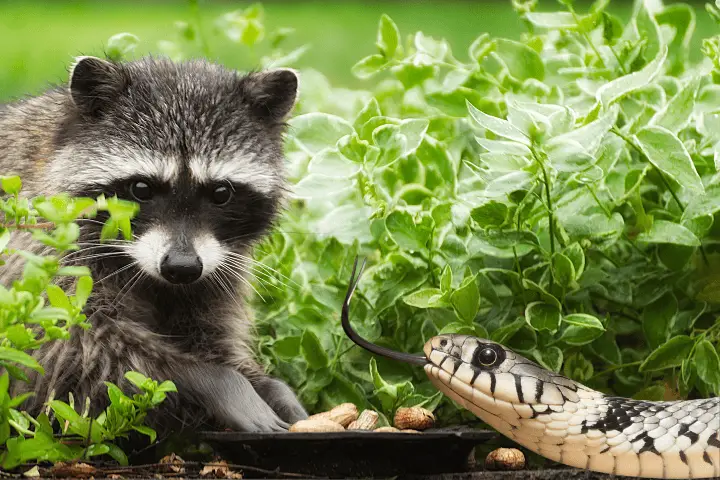Do Racoons Eat Snakes
Raccoons are amazing creatures, well-known for their mischievous behavior and black masks. They are omnivores, and their diet is made up of different food items.
Do they eat snakes?
Nature provides for all. Raccoons usually consume fruits, nuts, insects, and small mammals. But sometimes, reptiles like snakes make an appearance on their menu.
These clever animals have a special advantage when hunting snakes – agility and dexterity. Their paws and claws make it easy to overpower slithery serpents.
Though, not all snakes are a match for them – venomous or larger ones may be too much for even these resourceful omnivores.
Raccoons may look adorable, but their passion for dumpsters and junk food make them expert snake-eaters.
Do raccoons eat snakes?
Raccoons are known for their omnivorous diet – they enjoy snakes too! These masked bandits have a taste for small mammals and invertebrates, but will not hesitate to snack on snakes when they can.
Raccoons are rather versatile when it comes to what they eat. Wherever snake populations thrive, raccoons may add them to their diet more often.
These agile creatures use their nimble paws and sharp claws to hunt and consume serpents. A wildlife expert once saw a determined raccoon snatch its dinner away from a Burmese python – without harm!
It’s amazing to see how animals find sustenance in their environment. Raccoons eating snakes is a great reminder of the diversity in nature, and the clever strategies these critters use to get their meals.
Background on raccoons
Raccoons, known as Procyon lotor, are fascinating critters. With their signature black mask and ringed tails, these fluffy animals have become a symbol of nature.
Raccoons are renowned for their adaptability in numerous habitats, like forests, cities, and even mountainous areas. Although they’re mostly nocturnal, they’re quite clever and curious – thriving both in rural and urban settings.
These omnivorous mammals have an assorted diet, including plants, fruits, nuts, insects, rodents, birds’ eggs, and even trash. But do raccoons eat snakes? Though they’re opportunistic feeders, they usually don’t target dangerous reptiles. Rather, they opt for easier snacks like fruits or bugs.
It’s important to recognize that snakes play a big role in sustaining balance in ecosystems. As predators, they help regulate rodent populations and other small animals that could disturb the ecological harmony. It’s best for raccoons and the environment if they don’t prey on them.
Background on snakes
Snakes are amazing reptiles! With over 3,000 known species, they come in various sizes and colors, and live in a wide range of habitats.
These cold-blooded creatures rely on external sources of heat to regulate their body temperature. They also have a special jaw that can dislocate and swallow large prey, like rodents, birds, and even other snakes.
Contrary to popular belief, most snakes are not venomous. In fact, they’re essential predators that limit populations of pests like rats and mice.
Plus, some snakes can even hunt venomous snakes, acting as natural pest control agents.
Instances of raccoons eating snakes
Instances of raccoons consuming snakes have been observed and documented in various regions. Showcasing their adaptability and opportunistic nature, these incidents prove that raccoons can hunt snakes despite being primarily omnivorous.
Plus, certain snake species are more vulnerable due to factors such as size, behavior, and habitat overlap. For instance, smaller snakes like garter snakes may be defeated by raccoons more often than larger venomous species.
Shelter and prey availability also factor into these interactions.
These encounters serve as a reminder of the complex dynamics within ecosystems. To gain a better understanding of the dietary habits and ecological roles of these creatures, researchers and wildlife enthusiasts must continue monitoring these occurrences.
Stay informed about the exciting meetings between raccoons and snakes in different habitats. By staying up-to-date, you can appreciate the diversity and intricacies of nature’s intricate web.
Factors influencing raccoon-snake interactions
Raccoons and snakes often meet in their natural habitats. Factors determine if raccoons eat them or coexist peacefully.
Gaining insights into this relationship is important.
Habitat affects the likelihood of raccoon-snake encounters. Raccoons live in wooded areas, whilst snakes are in forests, grasslands and cities.
This increases chances of interaction.
Food availability impacts the behaviour of both animals. Raccoons are omnivores and eat fruits, insects, small mammals and snakes.
When food is scarce, they may eat snakes for an alternative.
Predator-prey dynamics affect raccoon-snake interactions. Some snakes can defend themselves, but some may be preyed on due to size.
Seasonal changes have an impact on the two species. Colder months mean competition for resources, leading to more predation.
Creating diverse habitats that suit both species helps with conflicts. Offering enough food for all inhabitants promotes harmonious coexistence.
Conclusion
Raccoons are well-known for their varied diet. They’ll eat fruits, veggies, bugs and small animals.
So, it’s no shock they may sometimes eat snakes. But that doesn’t mean snakes are their main food source.
When it comes to snakes, raccoons are opportunistic eaters. They’ll only munch on them if the moment arises and they’re hungry.
Raccoons have been seen eating little snakes, but it’s not a usual thing for them.
It’s vital to remember raccoons normally hunt for easier and more available food sources like garbage bins or bird nests.
Snakes aren’t their priority. Also, the size of the snake decides if a raccoon will attempt to catch and chow down on it.

